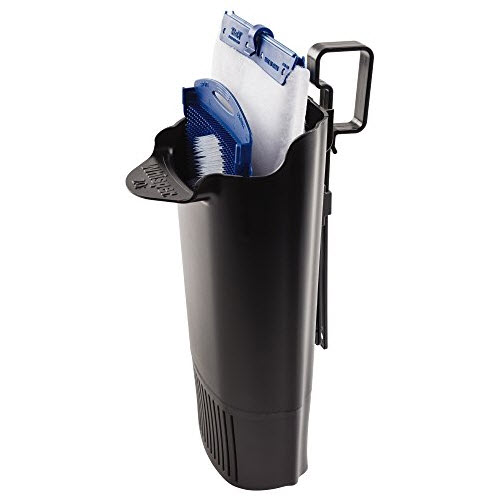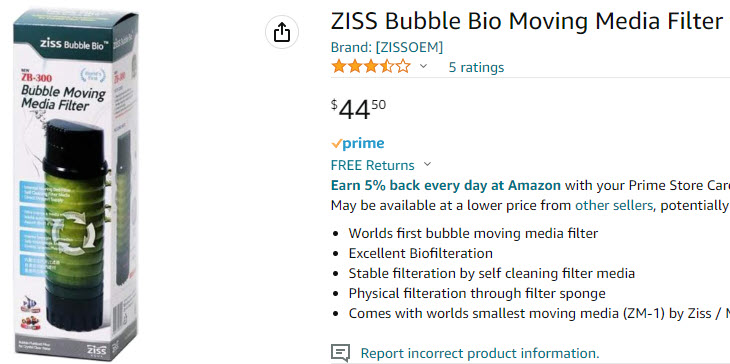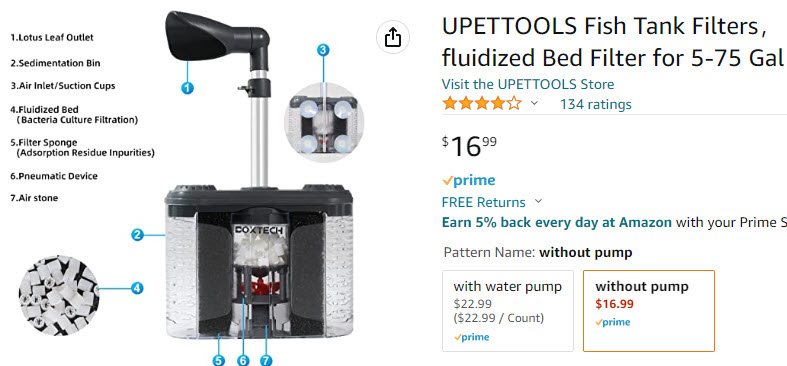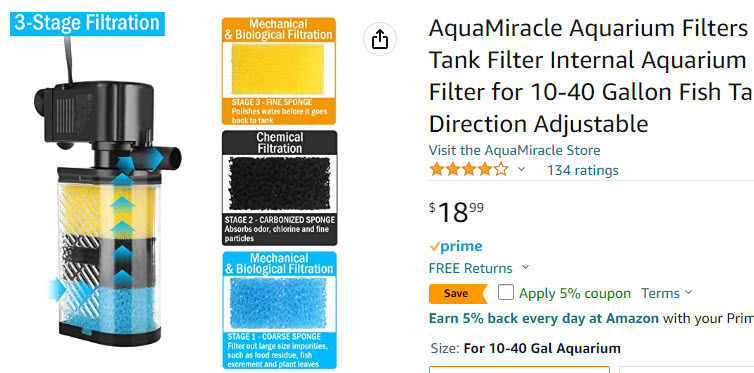
Let me make one thing very clear:
.
SMALL filters do decent filtration in SMALL aquariums with SMALL numbers of SMALL fish
.
Do not put a small filter in a 30 gallon tank with five angelfish, three pearl gouramis and five swordtails and expect to have an ammonia free aquarium with crystal clear water. It won’t happen.
Box or Corner Filter
A filter that used to come with all aquarium kits sold was a box filter or corner filter. These filters are still sold for betta aquariums and the like. They are very cheap, as low as $3. If these small in tank filters are filled with a good media such as plastic pot scrubbers or static K1 media and cleaned very rarely they can be an decent biofilter for a small aquarium with small numbers of small fish.

Note that unfortunately small corner filters are most often filled with a small amount of ceramic rings which is simply worthless in the aquarium. Also newcomers often clean their filter media to get rid of the “horrible brown gunk”. They don’t realize this “gunk” is their beneficial bacteria. Poor media and/or frequent cleaning guarantee a small filter won’t do much of ANYTHING, even in a small aquarium with a small bioload.
The other filter media often seen in these corner filters is polyester floss. This floss is typically packed in tightly. Because it is packed in tightly it rather quickly becomes plugged and needs to be replaced every week or so. This insures that the filter will not do its main job, namely rendering ammonia harmless. So polyester floss is NOT a good idea.
Cartridge Filters
Most small aquarium kits sold now have small in tank cartridge filters.

There are also a whole series of small hang on back cartridge filters sold for the small aquarium. These have the same features as the in tank cartridge filter, they are just outside the aquarium.
.

.
The plastic inserts found in some of them will become coated with brown gunk and become very good biofilters. But most of these cartridge filters only have a cartridge. If these filters have only the cartridges they are pretty worthless, especially if they are replaced per the directions on a monthly basis. If they are modified with foam insets as shown by Cory of Aquarium Co-op (see the chapter on hang-on-back filters), they become decent small filters.
8.2. Hang-on-Back Filters
.
Small Sponge Filters
Another useful commercially available small filter is the small sponge filters. These are excellent for small tanks but many don’t like their aesthetics. The foam surface becomes covered in rather ugly goop after a while. If one has a small five or ten gallon tank I recommend using a small Aquarium Co-op sponge filter with an airstone and a decent sized air pump. Just do not clean with more than two squeezes in a bucket of water. Never clean a sponge filter under running water. And only clean once every two months or so.

Air Operated Fluidized Bed Filters
Then there are small in tank fluidized bed filters put out by Ziss, Aqqa and Qanvee. Because the entire body of the filter acts like an air lift tube these filters actually are decent filters. They are especially good since they use a micro K1 fluidized bed to do the filtration and this is the best filter media there is. Unfortunately when there is the least bit of GH in the water the air bubbler shuts down here and there is no good way to replace it. On this basis I do not recommend this filter.

.
Upettools Boxtech Fluidized Bed Filter
One small aquarium filter is a fluidized bed/foam filter which will actually work very well. It is the Upettools Boxtech Filter. It combines an airstone with sponge and a tiny fluidized bed. It has an air lift tube and will move the water through the filter. This is a very good design for a small aquarium under 20 gallons.
.

.
Small Powerhead/Foam Filters
There are a whole series of small filters that use powerheads in combination with foam. Just pack the whole thing with the large pore foam (blue foam “mechanical” filtration) and leave it be (ignore the directions that say to replace the foam frequently). These are decent filters for small aquariums 20 gallons and under.

.
Small Do It Yourself (DIY) Filters
There are a whole series of DIY filters which can be made quite cheaply. Some of these are VERY good options for ANY aquarium. They can be found in this article:
8.7.8. Small DIY Filters
.
Return to Filter Menu
Return to Other Filter Menu
.
Aquarium Science Website
The chapters shown below or on the right side in maroon lead to close to 400 articles on all aspects of keeping a freshwater aquarium. These articles have NO links to profit making sites and are thus unbiased in their recommendations, unlike all the for-profit sites you will find with Google. Bookmark and browse!
.

Dave says
In reply to April ……. Go with an initial layer of either 30 ppi foam or filter floss for mechanical. Then layer foam or K1 micro in bags for biofiltration.
April says
You don’t recommend filter floss, which is in the last section of my new internal UV filter with removable media tubes. You went over many different filter medias, but I’m still unsure about what about be best in my 20 long. I want some mechanical filtration, I already have a sponge filter. Whatever I use must be easy to cut/manipulate (like floss, a sponge, etc), as the UV bulb goes down the center of the media tubes.
Thanks for your advice, and thanks for keeping it real.
ben z says
there is one arrangement in which designs like the ziss bubble bio can actually work quite well. if the outlet is above the water level, the filter body becomes the lift tube. i saw this in action at a shop and thought using it that way might actually make for some interesting albeit unorthodox aquascapes in small tanks. The water flow is surprisingly decent too. Just an idea.
Dave says
In reply to Sammy …. You are correct. No need for any air stone.
Sammy Savill says
Hi Dave
Yeah, me again.
My neighbor has those small powerhead foam filters like you show in this article. He wondered if a nano bubble air stone under or beside would oxygenate the bacteria in the foam better and help them multiply. Would it assist or just burn out the powerhead quicker?
I feel that good oxygenated water being drawn in would suffice but it is just a guess.
Dave says
In reply to Hilary … Yep, all you can do is double up for a month or so. Unless you happen to have some human antibiotics left over somewhere.
Hilary says
Thanks Dave!
A follow up: I’ve noticed what I suspect to be epistylis on one of my kubotai in that tank, and possibly some signs on another kubotai or ember. (Hard to tell sometimes when the fish are so small and iridescent.)
Obviously increasing filtration is one of the biggest things I can do to combat this longer term. But, will switching over filters now cause more of an issue? In terms of initially losing bio filtration. Or will doubling up while transitioning cover that.
(Antibiotics aren’t an accessible option as I’m in British Columbia)